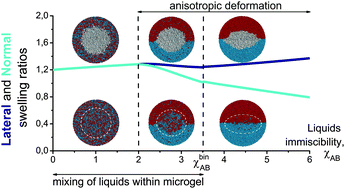A polymer microgel at a liquid–liquid interface: theory vs. computer simulations
Abstract
We propose a mean-field theory and dissipative particle dynamics (DPD) simulations of swelling and collapse of a polymer microgel adsorbed at the interface of two immiscible liquids (A and B). The microgel reveals surface activity and lowers A–B interfacial tension. Attempting to occupy as large an interfacial area as possible, the microgel undergoes anisotropic deformation and adopts a flattened shape. Spreading over the interface is restricted by polymer subchain elasticity. The equilibrium shape of the microgel at the interface depends on its size. Small microgels are shown to be more oblate than the larger microgels. Increasing microgel cross-link density results in stronger reduction of the surface tension and weaker flattening. As the degree of immiscibility of A and B liquids increases, the microgel volume changes in a non-monotonous fashion: the microgel contraction at moderate immiscibility of A and B liquids is followed by its swelling at high incompatibility of the liquids. The segregation regime of the liquids within and outside the microgel is different. Being segregated outside the microgel, the liquids can be fully (homogeneously) mixed or weakly segregated within it. The density profiles of the liquids and the polymer were plotted under different conditions. The theoretical and the DPD simulation results are in good agreement. We hope that our findings will be useful for the design of stimuli responsive emulsions, which are stabilized by the microgel particles, as well as for their practical applications, for instance, in biocatalysis.


 Please wait while we load your content...
Please wait while we load your content...